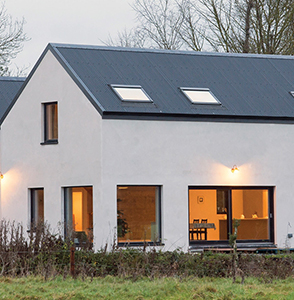Passive House
The key of how passive house performs lays on well designed ventilating which can not only filtrating too much moisture in the air and peculiar smell but pollen and dust, providing clean and fresh air for rooms. If you open the window for ventilation, a lot of quantity of heat will be lost, and the loss is more than the total quantity of heat that a passive house needs. Under most climate conditions, passive house wants certain heating but the quantities are small, which can be realized by ventilating. Through heating coil to warm up fresh air, the heating needs left can be met, and that is the concept of the fresh air system of passive house for supplying heating.
Principle of the ventilation of passive house
The basic principle of the ventilation of passive house: the muddy air in kitchen and bathroom is extracted (air exhaust) and the fresh air will be delivered in to where people live (air supply), and automatic air exhaust can be realized in hallway. For example, the standard of fresh air is 20m2/h for one person and per capital living space is 30m so that the quantity of air supply should be 1m/2(m?h). the highest temperature is limited as 50 ℃ and the corresponding heat load is 10W/m* in order to avoid the peculiar smell produced by excessive temperature causing the dust to be burned, meeting the requirement of heat supply.
The functions of ventilating
Ventilating, able to recycle the heat efficiently, emphasizes its own main functions: it can change the indoor air, which can control the air humidity in case of mildewing; it can stop the accumulation of pollutants and it can remove the peculiar smell. In addition, there are additional functions: it can regulate the indoor air and clean the air ( acts as filter) to eliminate PM2.5; it can work as humidifying and dehumidification. Passive house applies the ventilating recycling the heat efficiently, lowering the heat loss, increasing the temperature of fresh air and enhancing the degree of comfort indoors. Meanwhile, the ventilating of passive house regulates the humidity indoors ( the optimal range is with relative humidity of 35%-55%), over or lower will do harm to health, especially the skin and respiratory system. If the temperature is too high, it will go mouldy; if the the temperature of internal surface is lower than 12.6℃, it will be liable to mildew; instead, the temperature of internal surface is lower than 9.6℃, condensation will happen. Too low temperature will possibly damage the floor or musical instrument.

Thenow Recommendation
